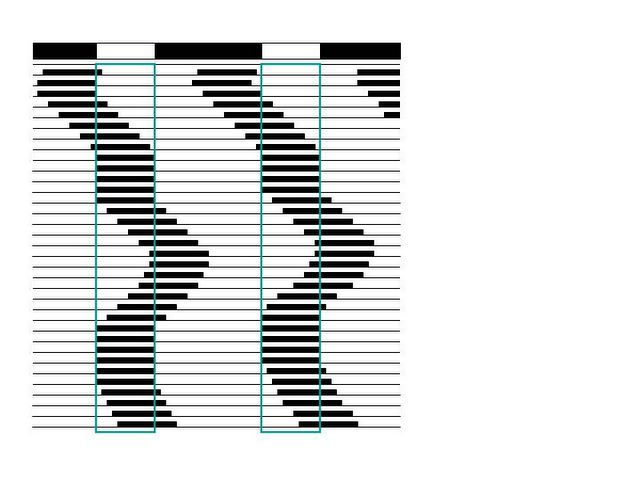

Disclaimer: I am not a medical doctor. These are my personal opinions. You should not use the information on this web page for diagnosing or treating a medical or health condition on your own. All decisions regarding patient care should be made with your healthcare provider.
What the sleep chart (double-plotted) below shows is called "scalloping". The chart is from Coturnix, Clock Tutorial #6: To Entrain Or Not To Entrain, That Is The Question, Science Blogs, 2009. You can see a fuller discussion in that article.

Scalloping is one of the things that can happen when a rhythm is clinging to a 24-hour schedule but just barely. Severe DSPS can show scalloping. It is as if your body starts to slip into a non-24 hour schedule but then pulls itself back just in time. It would still be classified as DSPS even though it is on the verge of N24. In scientific terms your system is at the limit of the range of entrainment.
Every organism has a range of entrainment. Someone who is "normal" may be able to entrain to a 24 hour day and perhaps to 24.5 or 25 hours or to 23.5 or 23. So their range of entrainment might be 23-25 hours. Someone with N24 might be able to entrain to a 26 hour day, plus or minus an hour. So they could entrain to a 26 hour day or a 25 hour day.
But they can't entrain to 24 hours. (The range does not have to be +/- 1 hour, it can be wider or narrower.)
But odd things happen when one tries to entrain to cycles that are near the extremes of one's range. The first thing that happens is a change in phase. Someone with a 24.7 hour cycle might be able to entrain to 24 hours but in a very delayed phase, i.e. DSPS.
When one is *very* close to the edge of the range of entrainment scalloping starts to occur. The sleep cycle bounces back and forth in a sine wave-like pattern. The sleep cycle is butting its head against the range and being thrust back again.
So it is really DSPS by definition since the average period is still 24 hours, but it is just a hair's breadth away from N24. Just a bit worse and it would be N24 with pronounced relative coordination and phase jumps. Then beyond that, completely free-running N24.
There is a good mathematical model of this behavior that was worked out by Rutger Wever, one of the giants of circadian research. See Wever R, Virtual synchronization towards the limits of the range of entrainment, J Theor Biol. 1972 Jul;36(1):119-32. So the same thing is happening in the chart above.
Scalloping indicates someone barely entrained. It can be an N24 who is temporarily forcing themselves to entrain, or it can be someone with DSPS that is very severe and on the edge of what could become N24. The actual scalloping looks the same. Only the history distinguishes the two.
For an analogy, suppose you saw someone clinging to a branch of a still-rooted tree while flood waters raged around them. There are two possible ways they could have ended up in that situation.